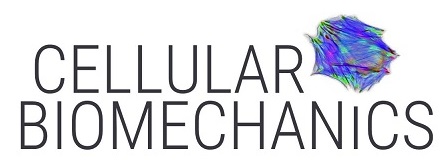Research
Mechanics of endocytosis
FORCES DURING VIRUS AND PARTICLE UPTAKE
Pathogens tailor their physical and chemical characteristics to gain entry into host cells. The overall goal of this project is to determine how cell sensing of the physico-chemical features of viruses and nanoparticles (NPs) regulates their uptake, and investigate the energies required to drive the endocytic process. The uptake process involves the fine-tuning of physical and chemical cues at the cellular interface which support optimal binding, cell membrane bending and uptake in cells. To decouple and quantify the chemical and mechanical contributions to the uptake process we designed two major methods to study early interactions of nanoparticles with cell surfaces: NP covalent immobilization on surfaces via click chemistry (Fratini et al) and NP linking to molecular sensors to measure molecular forces generated upon binding (Wiegand et al; Pennarola et al).
Main lab member involved: Federica Pennarola (PhD) (Heidelberg)
INFLUENCE OF THE PLASMA MEMBRANE ON CELL MECHANICS
The plasma membrane acts both as a barrier and a center for communication. We are interested in the role of the plasma membrane and its different lipids in the biomechanical crosstalk between cells and their environment. This ranges from the biophysical properties of the membrane to the membrane dynamics during particle uptake and how cells communicate with each other.
Main lab member involved: Lena Strieker (PhD) (Heidelberg)
Molecular regulation of adhesion and migration
NANOSCALE ADHESION AND MIGRATION
We are interested in the integration of materials and science with cell biology at the nanoscale since it allows the study of cell adhesion signalling at a single cell and collective cell level. In particular, we have developed a micro-nanopatterning setup to control integrin clustering in migrating cells in 1D and 2D environments with different adhesive peptides using nanotechnology and photopatterning.
Main lab members involved: Victoria Levario Diaz (PostDoc), Mateo Andrés Ceballos Giraldo and Benjamin Will-Yeap (Bayreuth)
We are interested in developing a 3D-1D tumoral microenvironment system to study the relevant factor between the mechanical property of 3D milieus and the pathology of cancer progression. In order to further mimic the presence of aligned collagen fibers in primary tumors, which allow cancer cells to migrate out of malignant tissues, a 1D micropatterned surface is established to resemble the process of invasion into lymph or blood vessels. In this project, we focus on studying how solid stress from a 3D milieus plays a role in cancer cell motility and mechanics behavior.
Main lab member involved: I Chen (PhD) (Heidelberg)
Collective dynamics and mechanics
Collective cell motion is involved in various biological processes, from the generation of curved epithelia to cancer invasion and metastasis. In our lab, we are interested in collective cell behaviours and their mechanical properties. We study how force generation and transmission can shape 2D and 3D cell arrangements. In particular, we focus on the molecular cues driving cell-cell and cell-substrate interactions.
- We study the effect of tissue fluidification on collective migration of cancer spheroids, from 2D to more 3D-like environments. This interdisciplinary research topic lies at the interface between cellular biology, physico-chemistry, microfabrication and microscopy. For example, using microfluidics, we try to understand how confinement and mechanical stress can tune the invasion of cell collectives. Main lab member involved: Grégoire Lemahieu (PhD) (Heidelberg)
- Epithelial monolayers occur in organisms in all forms, from spherical in alveoli to tubular in the kidney. This project investigates the biophysical mechanisms involved in the formation and rigidity of such 3D epithelial cell collectives at the molecular level. Thereby, focusing on cell-cell adhesion and the force generation and transmission across cells. With these investigations, we want to shed light on how adherent junctions contribute to the stability of curved epithelial monolayers. Main lab member involved: Michelle Kemper (PhD) (Heidelberg)


